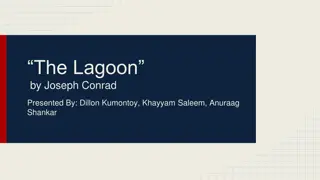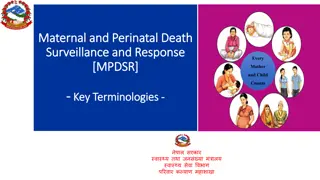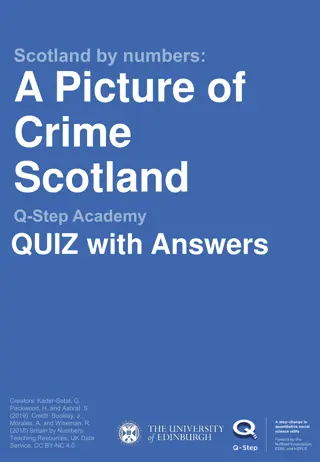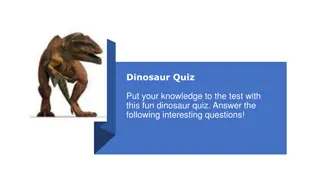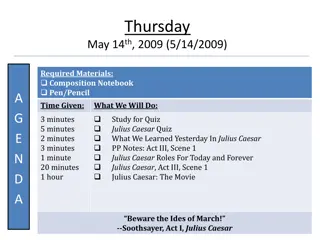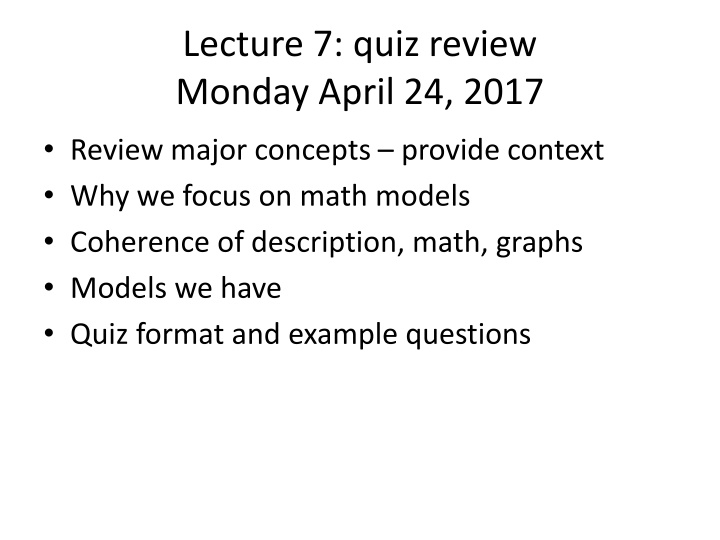
Math Models for Population Growth: Quiz Review & Major Concepts
Explore the significance of math models in simplifying real-world scenarios, focusing on linear, exponential, and logistic growth models. Dive into example questions and concepts for a comprehensive review ahead of the quiz.
Download Presentation

Please find below an Image/Link to download the presentation.
The content on the website is provided AS IS for your information and personal use only. It may not be sold, licensed, or shared on other websites without obtaining consent from the author. If you encounter any issues during the download, it is possible that the publisher has removed the file from their server.
You are allowed to download the files provided on this website for personal or commercial use, subject to the condition that they are used lawfully. All files are the property of their respective owners.
The content on the website is provided AS IS for your information and personal use only. It may not be sold, licensed, or shared on other websites without obtaining consent from the author.
E N D
Presentation Transcript
Lecture 7: quiz review Monday April 24, 2017 Review major concepts provide context Why we focus on math models Coherence of description, math, graphs Models we have Quiz format and example questions
Major concepts From reading From lecture notes
Math models Models simplify the real world Need assumptions Make predictions that can be tested
Example model Population has exponential growth Currently 100 individuals Net growth rate is .2 per month per individual Assumptions No major immigration or emigration Predict that in 6 months it will be N6= N0*e^(6*.2) = 332
Coherence/multiple descriptions Description Population is increasing at a constant rate per capita at first but then levels off and reaches a max population at around 500 individuals The initial doubling time is 2 weeks Math model Logistic equation: K = 500 convert tdto r 0.69/td = r Graph Sigmoidal N goes from 0 to 500 and time is in weeks
We have 5 models Linear growth Exponential growth Logistic growth MSY Allee effect 4500 4000 3500 3000 2500 linear exponential 2000 logisitc 1500 1000 500 0 0 10 20 30
Linear growth model Draw dN/dt vs. N 350 linear 300 linear 250 200 150 100 50 0 0 5 10 15 20 25 30
Exponential growth Draw N vs time exp dN/dt vs N 700 600 500 400 300 200 100 0 0 1000 2000 3000 4000 5000
Logistic growth N vs time dN/dt vs N logisitc N vs time log dN/dt vs. N 500 30 450 25 400 350 20 300 250 15 200 10 150 100 5 50 0 0 0 5 10 15 20 25 30 0 100 200 300 400 500
Logistic growth variations Overshoot For N>K , dN/dt is <0, more deaths than birthss Fluctuations Delay in population response, i.e. time lag Fluctuations can be damped or extreme
MSY Based on truncating the logistic curve at maximum dN/dt Maxiumum dN/dt at 250 log dN/dt vs. N 30 25 20 15 10 5 0 0 100 200 300 400 500
Allee effect and minimum viable population Pop vs time with different starting populations dN/dt vs population
Exam format Timed to take an hour 25 points Vocabulary and concepts (about 10 questions) Mechanics of calculating and graphing (10 points) Like we just went through and the problem sets Application (5 points) Low overall points but it s a combination of concepts and calculations


